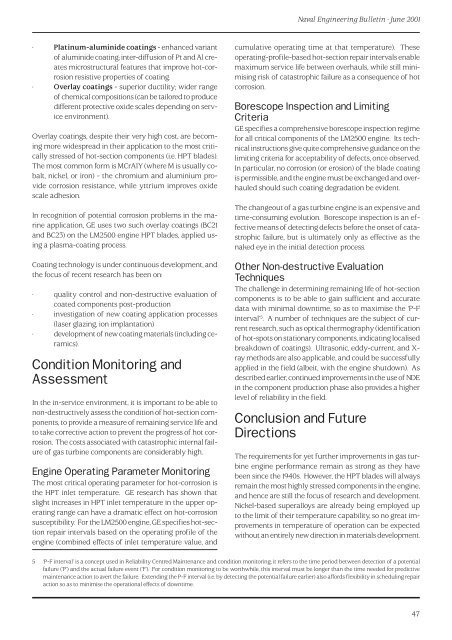Engineering - Royal Australian Navy
Engineering - Royal Australian Navy
Engineering - Royal Australian Navy
Create successful ePaper yourself
Turn your PDF publications into a flip-book with our unique Google optimized e-Paper software.
Naval <strong>Engineering</strong> Bulletin • June 2001<br />
• Platinum-aluminide coatings - enhanced variant<br />
of aluminide coating; inter-diffusion of Pt and Al creates<br />
microstructural features that improve hot-corrosion<br />
resistive properties of coating.<br />
• Overlay coatings - superior ductility; wider range<br />
of chemical compositions (can be tailored to produce<br />
different protective oxide scales depending on service<br />
environment).<br />
Overlay coatings, despite their very high cost, are becoming<br />
more widespread in their application to the most critically<br />
stressed of hot-section components (i.e. HPT blades).<br />
The most common form is MCrAlY (where M is usually cobalt,<br />
nickel, or iron) - the chromium and aluminium provide<br />
corrosion resistance, while yttrium improves oxide<br />
scale adhesion.<br />
In recognition of potential corrosion problems in the marine<br />
application, GE uses two such overlay coatings (BC21<br />
and BC23) on the LM2500 engine HPT blades, applied using<br />
a plasma-coating process.<br />
Coating technology is under continuous development, and<br />
the focus of recent research has been on:<br />
• quality control and non-destructive evaluation of<br />
coated components post-production<br />
• investigation of new coating application processes<br />
(laser glazing, ion implantation)<br />
• development of new coating materials (including ceramics).<br />
Condition Monitoring and<br />
Assessment<br />
In the in-service environment, it is important to be able to<br />
non-destructively assess the condition of hot-section components,<br />
to provide a measure of remaining service life and<br />
to take corrective action to prevent the progress of hot corrosion.<br />
The costs associated with catastrophic internal failure<br />
of gas turbine components are considerably high.<br />
Engine Operating Parameter Monitoring<br />
The most critical operating parameter for hot-corrosion is<br />
the HPT inlet temperature. GE research has shown that<br />
slight increases in HPT inlet temperature in the upper operating<br />
range can have a dramatic effect on hot-corrosion<br />
susceptibility. For the LM2500 engine, GE specifies hot-section<br />
repair intervals based on the operating profile of the<br />
engine (combined effects of inlet temperature value, and<br />
cumulative operating time at that temperature). These<br />
operating-profile-based hot-section repair intervals enable<br />
maximum service life between overhauls, while still minimising<br />
risk of catastrophic failure as a consequence of hot<br />
corrosion.<br />
Borescope Inspection and Limiting<br />
Criteria<br />
GE specifies a comprehensive borescope inspection regime<br />
for all critical components of the LM2500 engine. Its technical<br />
instructions give quite comprehensive guidance on the<br />
limiting criteria for acceptability of defects, once observed.<br />
In particular, no corrosion (or erosion) of the blade coating<br />
is permissible, and the engine must be exchanged and overhauled<br />
should such coating degradation be evident.<br />
The changeout of a gas turbine engine is an expensive and<br />
time-consuming evolution. Borescope inspection is an effective<br />
means of detecting defects before the onset of catastrophic<br />
failure, but is ultimately only as effective as the<br />
naked eye in the initial detection process.<br />
Other Non-destructive Evaluation<br />
Techniques<br />
The challenge in determining remaining life of hot-section<br />
components is to be able to gain sufficient and accurate<br />
data with minimal downtime, so as to maximise the ‘P-F<br />
interval’ 5 . A number of techniques are the subject of current<br />
research, such as optical thermography (identification<br />
of hot-spots on stationary components, indicating localised<br />
breakdown of coatings). Ultrasonic, eddy-current, and X-<br />
ray methods are also applicable, and could be successfully<br />
applied in the field (albeit, with the engine shutdown). As<br />
described earlier, continued improvements in the use of NDE<br />
in the component production phase also provides a higher<br />
level of reliability in the field.<br />
Conclusion and Future<br />
Directions<br />
The requirements for yet further improvements in gas turbine<br />
engine performance remain as strong as they have<br />
been since the 1940s. However, the HPT blades will always<br />
remain the most highly stressed components in the engine,<br />
and hence are still the focus of research and development.<br />
Nickel-based superalloys are already being employed up<br />
to the limit of their temperature capability, so no great improvements<br />
in temperature of operation can be expected<br />
without an entirely new direction in materials development.<br />
5 ‘P-F interval’ is a concept used in Reliability Centred Maintenance and condition monitoring; it refers to the time period between detection of a potential<br />
failure (‘P’) and the actual failure event (‘F’). For condition monitoring to be worthwhile, this interval must be longer than the time needed for predictive<br />
maintenance action to avert the failure. Extending the P-F interval (i.e. by detecting the potential failure earlier) also affords flexibility in scheduling repair<br />
action so as to minimise the operational effects of downtime.<br />
47
















